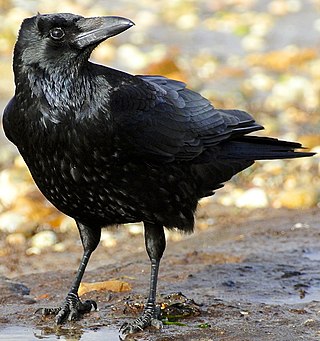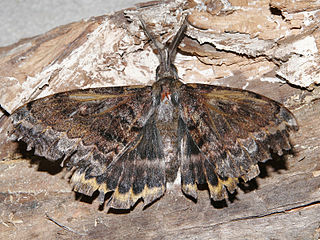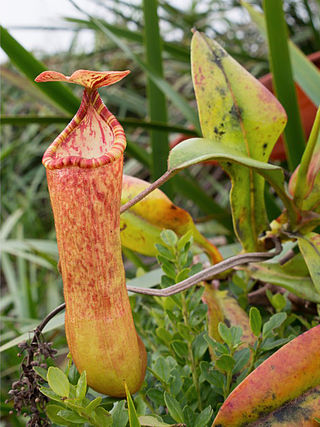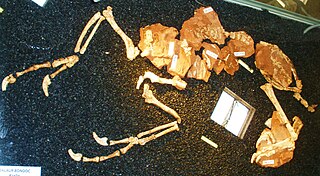
The order Lamiales are an order in the asterid group of dicotyledonous flowering plants. It includes about 23,810 species, 1,059 genera, and is divided into about 25 families. These families include Acanthaceae, Bignoniaceae, Byblidaceae, Calceolariaceae,Carlemanniaceae, Gesneriaceae, Lamiaceae, Lentibulariaceae, Linderniaceae, Martyniaceae, Mazaceae, Oleaceae, Orobanchaceae, Paulowniaceae, Pedaliaceae, Peltantheraceae, Phrymaceae, Plantaginaceae, Plocospermataceae, Schlegeliaceae, Scrophulariaceae, Stilbaceae, Tetrachondraceae, Thomandersiaceae, Verbenaceae.

In biology, taxonomy is the scientific study of naming, defining (circumscribing) and classifying groups of biological organisms based on shared characteristics. Organisms are grouped into taxa and these groups are given a taxonomic rank; groups of a given rank can be aggregated to form a more inclusive group of higher rank, thus creating a taxonomic hierarchy. The principal ranks in modern use are domain, kingdom, phylum, class, order, family, genus, and species. The Swedish botanist Carl Linnaeus is regarded as the founder of the current system of taxonomy, as he developed a ranked system known as Linnaean taxonomy for categorizing organisms and binomial nomenclature for naming organisms.

The carrion crow is a passerine bird of the family Corvidae and the genus Corvus which is native to western Europe and the eastern Palearctic.

Grand Theft Auto: San Andreas is a 2004 action-adventure game developed by Rockstar North and published by Rockstar Games. It is the fifth main entry in the Grand Theft Auto series, following 2002's Grand Theft Auto: Vice City, and the seventh installment overall. It was released in October 2004 for the PlayStation 2, in June 2005 for Microsoft Windows and Xbox, and in November 2010 for Mac OS X. The game is set within an open world environment that players can explore and interact with at their leisure. The story follows Carl "CJ" Johnson, who returns home following his mother's murder and is drawn back into his former gang and a life of crime while clashing with corrupt authorities and powerful criminals. Carl's journey takes him across the fictional U.S. state of San Andreas, which is based on California and Nevada and encompasses three major cities: Los Santos, San Fierro and Las Venturas.

Systema Naturae is one of the major works of the Swedish botanist, zoologist and physician Carl Linnaeus (1707–1778) and introduced the Linnaean taxonomy. Although the system, now known as binomial nomenclature, was partially developed by the Bauhin brothers, Gaspard and Johann, Linnaeus was first to use it consistently throughout his book. The first edition was published in 1735. The full title of the 10th edition (1758), which was the most important one, was Systema naturæ per regna tria naturæ, secundum classes, ordines, genera, species, cum characteribus, differentiis, synonymis, locis or translated: "System of nature through the three kingdoms of nature, according to classes, orders, genera and species, with characters, differences, synonyms, places".

The Carrizo Plain is a large enclosed grassland plain, approximately 50 miles (80 km) long and up to 15 miles (24 km) across, in southeastern San Luis Obispo County, California, about 100 miles (160 km) northwest of Los Angeles. It contains the 246,812-acre (99,881 ha) Carrizo Plain National Monument, and it is the largest single native grassland remaining in California. It includes Painted Rock in the Carrizo Plain Rock Art Discontiguous District, which is listed on the National Register of Historic Places. In 2012 it was further designated a National Historic Landmark due to its archeological value. The San Andreas Fault occurs along the eastern edge of the Carrizo Plain at the western base of the Temblor Range.

The Pyraloidea are a moth superfamily containing about 16,000 described species worldwide, and probably at least as many more remain to be described. They are generally fairly small moths, and as such, they have been traditionally associated with the paraphyletic Microlepidoptera.

Entandrophragma is a genus of eleven known species of deciduous trees in the family Meliaceae.

Anthelidae is a family of Australian lappet moths in the order Lepidoptera. It had earlier been considered to be part of the Lasiocampoidea superfamily, but a 2008 molecular phylogenetic study, supported by a 2011 study, resulted in reincluding the Anthelidae in the superfamily Bombycoidea.

Nepenthes sumagaya is a tropical pitcher plant native to the Philippines. It is known only from Mount Sumagaya in north-central Mindanao, where it grows in open areas at elevations from 1600 m above sea level to the summit at 2247 m. It is sympatric with N. pantaronensis and possible hybrids between these species have been recorded. Owing to its unusual combination of morphological characters, N. sumagaya has no obvious close relatives in the genus.

Protostomia is the clade of animals once thought to be characterized by the formation of the organism's mouth before its anus during embryonic development. This nature has since been discovered to be extremely variable among Protostomia's members, although the reverse is typically true of its sister clade, Deuterostomia. Well known examples of protostomes are arthropods, molluscs, annelids, flatworms and nematodes. They are also called schizocoelomates since schizocoely typically occurs in them.
The World Register of Marine Species (WoRMS) is a taxonomic database that aims to provide an authoritative and comprehensive list of names of marine organisms.

Balaur is a genus of theropod dinosaur from the late Cretaceous period, in what is now Romania. It is the type species of the monotypic genus Balaur, after the balaur, a dragon of Romanian folklore. The specific name bondoc means "stocky", so Balaur bondoc means "stocky dragon" in Romanian. This name refers to the greater musculature that Balaur had compared to its relatives. The genus, which was first described by scientists in August 2010, is known from two partial skeletons.

Anguanax is an extinct genus of basal pliosaurid known from the Late Jurassic Rosso Ammonitico Veronese Formation of northern Italy. It contains a single species, Anguanax zignoi, known from a partially complete individual, representing the first articulated skeleton of an Italian plesiosaurian.
Wangosaurus is an extinct genus of basal pistosauroid known from the Middle Triassic Falang Formation of Xingyi in Guizhou Province, southwestern China. It contains a single species, Wangosaurus brevirostris, first described and named by Le-Tian Ma, Da-Yong Jiang, Olivier Rieppel, Ryosuke Motani and Andrea Tintori in 2015. The specific name brevirostris comes from Greek for "short snout". It is known solely from its holotype, a nearly complete and articulated skeleton measuring 2.2 m (7.2 ft) long.
Majiashanosaurus is an extinct genus of pachypleurosaur or alternatively a basal eosauropterygian known from the Early Triassic of Anhui Province, eastern China. It contains a single species, Majiashanosaurus discocoracoidis.
Cerradopatus is a monospecific genus of velvet worm containing the single species Cerradopatus sucuriuensis. Males of this species have 28 or 29 pairs of legs; females have 30 to 32. This species is native to the Brazilian savannah. This species is viviparous, with mothers supplying nourishment to their embryos through a placenta.
Peripatus evelinae is a species of velvet worm in the Peripatidae family. The male of this species has 33 pairs of legs; females have 35 or 36 leg pairs. This species has more legs than any other species of Peripatus; the females of the other species have at most 34 leg pairs, and the males have at most 32. The original description of P. evelinae was based on two specimens and reported females with 32 and 34 leg pairs, but another examination of these specimens revealed a male with 33 leg pairs and a female with 35 leg pairs instead as well as numerous embryos, including females with 35 and 36 leg pairs. The male specimen is 44 mm long; the female is 65 mm long. The type locality is in Goiás, Brazil.
Hypericum antiquum is an extinct species of the genus Hypericum that was present during the Eocene epoch. The species' fossils are the oldest collected of Hypericum, and it is believed that the species is the common ancestor of the tribe Hypericeae. Fossil seeds have been found in Russia, and the predicted paleoregion of the species stretched across Eurasia. It is theorized that one factor leading to the species' extinction is a global cooling at the end of the Eocene that removed much of its habitat.
Hypericum holyi is an extinct species of the genus Hypericum that was present from the Lower Miocene to the Upper Miocene. Fossil seeds of the species have been found in Central Europe in general and Central Jutland, Denmark, in particular.












